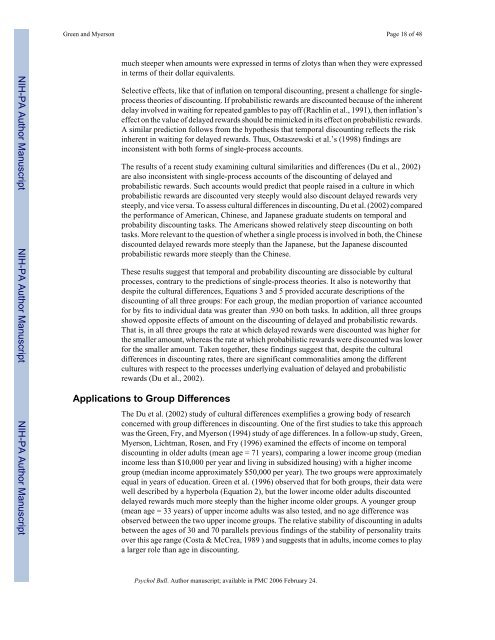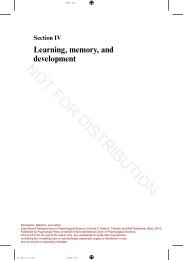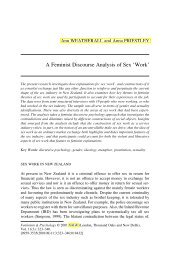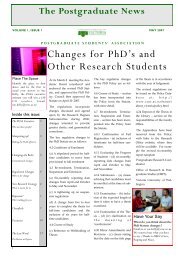green & myerson 2004.. - of /courses
green & myerson 2004.. - of /courses
green & myerson 2004.. - of /courses
Create successful ePaper yourself
Turn your PDF publications into a flip-book with our unique Google optimized e-Paper software.
Green and Myerson Page 18 <strong>of</strong> 48<br />
NIH-PA Author Manuscript NIH-PA Author Manuscript NIH-PA Author Manuscript<br />
much steeper when amounts were expressed in terms <strong>of</strong> zlotys than when they were expressed<br />
in terms <strong>of</strong> their dollar equivalents.<br />
Selective effects, like that <strong>of</strong> inflation on temporal discounting, present a challenge for singleprocess<br />
theories <strong>of</strong> discounting. If probabilistic rewards are discounted because <strong>of</strong> the inherent<br />
delay involved in waiting for repeated gambles to pay <strong>of</strong>f (Rachlin et al., 1991), then inflation’s<br />
effect on the value <strong>of</strong> delayed rewards should be mimicked in its effect on probabilistic rewards.<br />
A similar prediction follows from the hypothesis that temporal discounting reflects the risk<br />
inherent in waiting for delayed rewards. Thus, Ostaszewski et al.’s (1998) findings are<br />
inconsistent with both forms <strong>of</strong> single-process accounts.<br />
The results <strong>of</strong> a recent study examining cultural similarities and differences (Du et al., 2002)<br />
are also inconsistent with single-process accounts <strong>of</strong> the discounting <strong>of</strong> delayed and<br />
probabilistic rewards. Such accounts would predict that people raised in a culture in which<br />
probabilistic rewards are discounted very steeply would also discount delayed rewards very<br />
steeply, and vice versa. To assess cultural differences in discounting, Du et al. (2002) compared<br />
the performance <strong>of</strong> American, Chinese, and Japanese graduate students on temporal and<br />
probability discounting tasks. The Americans showed relatively steep discounting on both<br />
tasks. More relevant to the question <strong>of</strong> whether a single process is involved in both, the Chinese<br />
discounted delayed rewards more steeply than the Japanese, but the Japanese discounted<br />
probabilistic rewards more steeply than the Chinese.<br />
These results suggest that temporal and probability discounting are dissociable by cultural<br />
processes, contrary to the predictions <strong>of</strong> single-process theories. It also is noteworthy that<br />
despite the cultural differences, Equations 3 and 5 provided accurate descriptions <strong>of</strong> the<br />
discounting <strong>of</strong> all three groups: For each group, the median proportion <strong>of</strong> variance accounted<br />
for by fits to individual data was greater than .930 on both tasks. In addition, all three groups<br />
showed opposite effects <strong>of</strong> amount on the discounting <strong>of</strong> delayed and probabilistic rewards.<br />
That is, in all three groups the rate at which delayed rewards were discounted was higher for<br />
the smaller amount, whereas the rate at which probabilistic rewards were discounted was lower<br />
for the smaller amount. Taken together, these findings suggest that, despite the cultural<br />
differences in discounting rates, there are significant commonalities among the different<br />
cultures with respect to the processes underlying evaluation <strong>of</strong> delayed and probabilistic<br />
rewards (Du et al., 2002).<br />
Applications to Group Differences<br />
The Du et al. (2002) study <strong>of</strong> cultural differences exemplifies a growing body <strong>of</strong> research<br />
concerned with group differences in discounting. One <strong>of</strong> the first studies to take this approach<br />
was the Green, Fry, and Myerson (1994) study <strong>of</strong> age differences. In a follow-up study, Green,<br />
Myerson, Lichtman, Rosen, and Fry (1996) examined the effects <strong>of</strong> income on temporal<br />
discounting in older adults (mean age = 71 years), comparing a lower income group (median<br />
income less than $10,000 per year and living in subsidized housing) with a higher income<br />
group (median income approximately $50,000 per year). The two groups were approximately<br />
equal in years <strong>of</strong> education. Green et al. (1996) observed that for both groups, their data were<br />
well described by a hyperbola (Equation 2), but the lower income older adults discounted<br />
delayed rewards much more steeply than the higher income older groups. A younger group<br />
(mean age = 33 years) <strong>of</strong> upper income adults was also tested, and no age difference was<br />
observed between the two upper income groups. The relative stability <strong>of</strong> discounting in adults<br />
between the ages <strong>of</strong> 30 and 70 parallels previous findings <strong>of</strong> the stability <strong>of</strong> personality traits<br />
over this age range (Costa & McCrea, 1989 ) and suggests that in adults, income comes to play<br />
a larger role than age in discounting.<br />
Psychol Bull. Author manuscript; available in PMC 2006 February 24.






